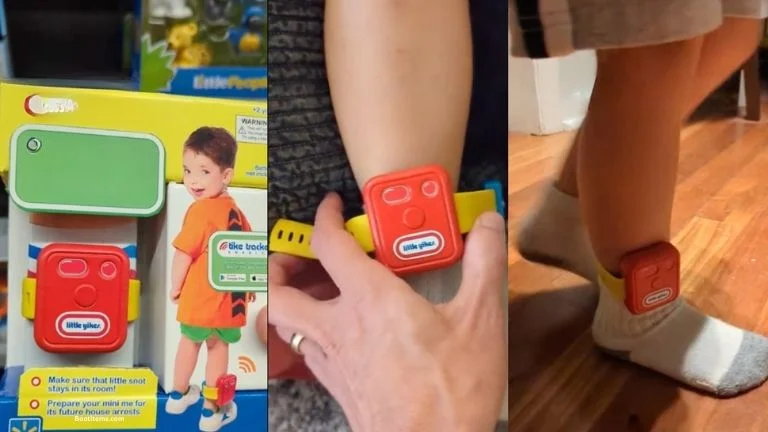My First Ankle Monitor: Facts, Myths, and Reality
The viral “My First Ankle Monitor” for kids is a satirical hoax created by @legbootlegit on TikTok. Ankle monitors are real devices used in the criminal justice system, not for children.
The Viral Hoax: “My First Ankle Monitor”
Origin and Spread of the Hoax
In August 2023, a video featuring a product called “My First Ankle Monitor” went viral on social media platforms, particularly TikTok. The video, created by the account @legbootlegit, showcased what appeared to be a children’s toy version of an ankle monitor, complete with packaging that parodied the well-known kids’ toy brand Little Tikes.
The satirical video quickly gained traction, amassing over 21 million views on TikTok alone. It then spread to other social media platforms, sparking discussions and reactions from users across the internet. The creator, known for producing parody videos of nonexistent spoof products, successfully fooled many viewers with this convincing yet absurd concept.
Public Reaction and Controversy
The video elicited a range of responses from the public. While many viewers found humor in the obvious satire, others expressed concern or outrage, believing the product to be real. Some social media users quickly pointed out the implausibility of the concept, with one Twitter user stating, “Ain’t no way they putting kids on house arrest lmao.”
The controversy surrounding the fake product highlighted societal concerns about child surveillance and the ethics of monitoring children’s movements. It also demonstrated the power of social media to spread misinformation rapidly, even when the content is clearly intended as satire.
Real Ankle Monitors: Purpose and Function
What Are Ankle Monitors?
Ankle monitors, also known as electronic monitoring devices, are legitimate tools used primarily in the criminal justice system. These devices are designed to track the location and movements of individuals who are required to wear them as part of their legal obligations.
Typically worn around the ankle, these monitors use GPS technology or radio frequency signals to provide real-time location data to authorities. The devices are securely fastened and cannot be removed without alerting officials, ensuring continuous monitoring of the wearer.
Uses in the Criminal Justice System
Ankle monitors serve several purposes within the criminal justice system:
- Alternative to Incarceration: For non-violent offenders, ankle monitors offer a way to serve sentences outside of prison, reducing overcrowding in correctional facilities.
- Pre-trial Monitoring: Individuals awaiting trial may be required to wear ankle monitors as a condition of their release, ensuring they do not flee or violate court-ordered restrictions.
- Parole and Probation: Offenders on parole or probation often wear ankle monitors to ensure compliance with the terms of their release, such as curfews or location restrictions.
- House Arrest: In some cases, ankle monitors are used to enforce house arrest, allowing authorities to ensure an individual remains within a specified area, typically their home.
The use of ankle monitors aims to balance public safety concerns with the goals of rehabilitation and reintegration into society. By providing a middle ground between incarceration and unrestricted release, these devices allow for closer supervision of individuals while potentially reducing the costs and negative impacts associated with imprisonment.
Living with an Ankle Monitor: Personal Experiences
Physical and Emotional Challenges
Wearing an ankle monitor presents numerous physical and emotional challenges for individuals subject to electronic monitoring. The device itself can be uncomfortable, causing physical discomfort and even pain in some cases. Many wearers report issues such as:
- Skin irritation and chafing where the device contacts the skin
- Difficulty finding comfortable positions for sleeping or sitting
- Limitations on clothing choices to conceal the device
- Discomfort during physical activities or exercise
Emotionally, the constant presence of the monitor serves as a persistent reminder of one’s legal situation. Wearers often experience feelings of shame, anxiety, and stigma associated with the visible device. The fear of technical malfunctions or accidental violations adds another layer of stress to daily life.
Impact on Daily Life and Relationships
The ankle monitor significantly affects various aspects of a wearer’s daily life and relationships:
- Employment: Finding and maintaining employment can be challenging, as the device may be visible or interfere with certain job requirements.
- Social Interactions: Wearers often feel self-conscious in social situations, fearing judgment or questions from others about the device.
- Family Dynamics: The restrictions associated with ankle monitoring can strain family relationships, limiting participation in family activities or events.
- Personal Freedom: Even when not incarcerated, wearers experience a significant loss of personal freedom due to movement restrictions and constant monitoring.
- Privacy Concerns: The continuous tracking of one’s location raises privacy issues and can lead to feelings of constant surveillance.
Restrictions and Compliance
Individuals wearing ankle monitors must adhere to a strict set of rules and restrictions:
- Movement Limitations: Wearers are often confined to specific areas, such as their homes or workplaces, with pre-approved schedules for movement.
- Curfews: Many monitoring programs include curfew requirements, restricting movement during certain hours.
- Exclusion Zones: Wearers may be prohibited from entering certain areas, such as schools, parks, or locations related to their offenses.
- Technical Maintenance: Regular charging of the device is crucial, often requiring the wearer to remain stationary near a power outlet for extended periods.
- Immediate Response: Any alerts or notifications from the device must be addressed promptly to avoid potential violations.
Compliance with these restrictions is critical, as violations can result in severe consequences, including a return to incarceration. The constant need to be aware of and adhere to these rules adds significant stress to the wearer’s daily life.

Technical Aspects of Ankle Monitors
How Ankle Monitors Work
Ankle monitors utilize various technologies to track the wearer’s location and movements:
- GPS Tracking: Many modern ankle monitors use Global Positioning System (GPS) technology to provide real-time location data. This allows authorities to track the wearer’s movements with high accuracy, often within a few meters.
- Radio Frequency (RF) Technology: Some monitors use RF signals to communicate with a base station installed in the wearer’s home. This type of monitoring is typically used for house arrest situations, alerting authorities if the wearer moves beyond a certain range from the base station.
- Cellular Technology: Many devices incorporate cellular technology to transmit data to monitoring centers, allowing for real-time tracking and communication even when the wearer is away from home.
- Tamper-Resistant Features: Ankle monitors are designed with various tamper-resistant mechanisms, such as fiber optic cables or pressure sensors, which trigger alerts if someone attempts to remove or damage the device.
Data Collection and Monitoring
The data collected by ankle monitors is typically transmitted to a central monitoring system managed by law enforcement or private companies contracted for this purpose. This system processes and analyzes the data to ensure compliance with the terms of the wearer’s release or sentence.
Key aspects of data collection and monitoring include:
- Location Tracking: The system records and stores the wearer’s location data, creating a detailed log of their movements.
- Schedule Compliance: For wearers with specific movement restrictions or curfews, the system checks their location against approved schedules.
- Exclusion Zone Alerts: If a wearer enters a prohibited area, the system generates immediate alerts to notify authorities.
- Battery Status: The monitoring system tracks the device’s battery level, alerting both the wearer and authorities when charging is needed.
- Tamper Alerts: Any attempts to remove or interfere with the device trigger immediate notifications to the monitoring center.
Privacy and Security Concerns
The use of ankle monitors raises significant privacy and security concerns:
- Data Protection: The extensive collection of location data creates risks related to data breaches or unauthorized access to sensitive information.
- Long-term Data Storage: Questions arise about how long the collected data is stored and who has access to this information after the monitoring period ends.
- Accuracy and False Alerts: Technical malfunctions or GPS inaccuracies can lead to false violation reports, potentially causing unwarranted legal issues for wearers.
- Overreach of Surveillance: Critics argue that continuous location tracking, even for individuals not incarcerated, represents an excessive invasion of privacy.
- Data Use Beyond Monitoring: Concerns exist about the potential use of collected data for purposes beyond the intended monitoring, such as in unrelated investigations or by third parties.
Balancing the need for effective monitoring with individual privacy rights remains a significant challenge in the use of ankle monitor technology.
Effectiveness and Controversies
Benefits of Ankle Monitoring
Proponents of ankle monitoring systems argue that they offer several benefits to both the justice system and monitored individuals:
- Reduced Incarceration: Ankle monitors provide an alternative to imprisonment, potentially reducing overcrowding in jails and prisons.
- Cost-Effectiveness: Electronic monitoring is often less expensive than incarceration, saving taxpayer money while still maintaining supervision.
- Rehabilitation Opportunities: By allowing individuals to remain in their communities, ankle monitors can facilitate better access to work, education, and support systems, potentially aiding in rehabilitation.
- Family Preservation: Monitored release allows individuals to maintain family connections and responsibilities, which can be crucial for long-term reintegration into society.
- Public Safety: Continuous monitoring can deter individuals from committing new offenses and allow for quick intervention if violations occur.
Criticisms and Ethical Concerns
Despite the purported benefits, ankle monitoring systems face significant criticisms and ethical concerns:
- Net-Widening Effect: Critics argue that electronic monitoring may be used excessively, subjecting individuals to surveillance who might otherwise have been granted unconditional release.
- Inequality in Application: There are concerns about disparities in who receives ankle monitors, with socioeconomic and racial factors potentially influencing decisions.
- Financial Burden: In many jurisdictions, monitored individuals must pay for their own devices, creating a significant financial strain, especially for low-income offenders.
- Psychological Impact: The constant presence of the monitor and associated restrictions can have severe psychological effects, including increased stress and stigma.
- Technical Reliability: Issues with device malfunctions, false alerts, or GPS inaccuracies can lead to wrongful violations and unnecessary stress for wearers.
- Privacy Infringement: The extensive data collection raises concerns about long-term privacy implications and potential misuse of information.
Research on Effectiveness
Studies on the effectiveness of ankle monitoring have produced mixed results:
- Recidivism Reduction: Some research suggests that electronic monitoring can reduce recidivism rates, particularly when combined with other support services.
- Compliance Improvement: Studies have shown that ankle monitors can increase compliance with court-ordered restrictions and reduce failure-to-appear rates for court dates.
- Cost Savings: Analysis often indicates that electronic monitoring is less expensive than incarceration, though the extent of savings varies.
- Limited Long-term Data: There is a lack of comprehensive long-term studies on the effects of ankle monitoring on rehabilitation and reintegration.
- Contextual Factors: The effectiveness of ankle monitoring appears to be influenced by various factors, including the specific population monitored, the length of monitoring, and the accompanying support services provided.
While ankle monitoring shows promise in certain areas, more research is needed to fully understand its long-term impacts and to address the ethical and practical concerns associated with its use.

Samantha Yates is a creative writer and journalist with expertise in content creation and editing. She holds an MA in Creative Writing and brings professional experience from Lionbridge, where she developed engaging content for leading technology companies







